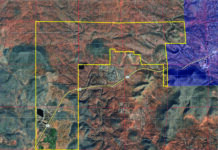It’s no secret that there is a housing shortage — or crisis, as some have called it — in Sedona. So whenever there is an opportunity to chip away at that problem, it appears that’s the goal of the Sedona City Council.
On Sept. 12, council had its second meeting with developer Paul Welker, who is seeking to build a Marriott Residence Inn. The meeting was discussion and direction only, so no action was taken.
The proposed hotel would be adjacent to the existing Courtyard by Marriott, which sits at the intersection of State Route 89A and Upper Red Rock Loop Road and is owned by Welker. It would sit on just over 3 acres with an additional 0.75 acres of open space, which would be used for drainage.
After receiving the nod from the Sedona Planning and Zoning Commission, Welker first came before City Council on May 23. In April, P&Z recommended this project for approval to council by a 5-1 vote. The commission had voted 4-2 to deny but after further discussion, Welker agreed to increase the number of employee units from two to five. A re-vote was taken and it received approval.
During the May council meeting, a sticking point for some, including Councilman Scott Jablow, was the number of employee housing units. And while the number was increased, he and others felt it should be even more.
Welker pointed out that it’s Marriott corporate policy to not have any on-site employee housing and that they had to seek permission to add them to this project.
The land is already zoned lodging and was part of the original zoning change when the Marriott Courtyard was approved. However, the zoning designation of lodging requires a zone change for any project that increases the total number of lodging units on a property. The zoning approved under the current zoning allowed for a maximum of 121 lodging units for Courtyard. Therefore, to build the additional 85 lodging units, a zone change to increase this number to 206 is required, according to a city report.
The report goes on to state that in reviewing this community benefit proposal, staff used the city’s Development Incentives and Guidelines for Affordable Housing. The DIGAH provides four methods of providing affordable housing: On-site, off-site, payment in-lieu of construction and dedication of land to the city or nonprofit for housing.
The 85-room hotel would include a mix of studio, one-bedroom and two-bedroom units, with the majority of the units being studios. In addition to the five employee units, Welker has agreed to provide other community benefits, which are required for a zone change. Some of these include:
- Contribution of $50,000 to the city’s affordable housing fund.
- Trailhead connection to Skywalker Trail, 15 trail parking stalls and a U.S. Forest Service kiosk.
- Shuttle service for guests.
- Access easement to the city’s odor treatment facility.
- Public art.
- Other associated site improvements.
In all, the community benefits listed total slightly less than $1.6 million. Councilman Jon Thompson said because of the city’s dire need, he would be in favor of eliminating many of the benefits Welker is offering if it meant he would be willing to add or build additional workforce housing.
“We need to step up now and say, ‘This needs to be solved,’” Thompson said of the housing problem, adding that at this point he would not be in favor of the project unless the employee housing offered is increased to at least 10 units.
The DIGAH recommends, but does not mandate, that affordable housing units associated with lodging developments should equal 12 percent of the number of lodging units proposed. Based on the originally proposed 88 new lodging units, 10.56 affordable housing units could be expected to be provided. When the Marriott Courtyard was approved, no employee housing units were required by the city.
During last week’s council meeting, the number of employee units being offered continued to be a concern for many on the council, especially considering what the DIGAH recommends.
“During the last three years we’ve worked with staff and through planning and zoning, these were the items [benefits] that were indicated to us that we should work on and that these would be community benefits. We didn’t just pull these out for this last meeting,” Welker said.
He went on to say, “Apparently the five units is not good. We’ve tried to make that work. It was at three and we boosted that to five. With everything else, we certainly felt this was a good package but now we’re hearing a different side of that story.”
To that, Mayor Sandy Moriarty said, “Things have changed. Once the governor made his deal with Airbnb, we ended up with a lot more short-term rentals than any of us had ever thought would be the case. It has turned our housing issue into a more urgent need. It really has turned into more of a crisis than it had been before.”
One option Jablow presented was to have Welker buy or build an off-site employee development with around 10 to 12 units. Welker said he’d be in favor of that idea if land — either in Sedona or possibly Cottonwood — could be found in lieu of having on-site employee housing.
“There’s a reason there’s not much affordable housing in Sedona. It’s because people who live here don’t particularly want affordable housing next door — not in my backyard,” Welker said. “And there’s not many sites to do that. We would be more open to that and to fulfill that obligation instead of trying to mix these two components [on-site housing] and trying to make it work.”


















